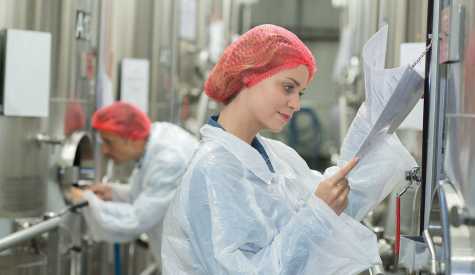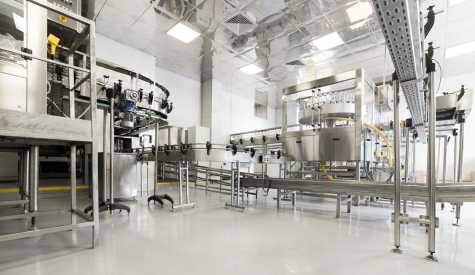Floor and Drain Cleaning in Food Manufacturing

Floors and drains are a commonly overlooked source of contamination in food manufacturing and processing facilities. Drains are a notorious source of foodborne pathogens, particularly Listeria monocytogenes. If your facility does not properly follow all cleaning and sanitizing procedures, your drains can develop biofilms. Biofilms are thin coatings of biological material, such as bacteria and other microorganisms, that form a layer over a surface. Biofilms can become resistant to regular floor and drain cleaning and sanitizing procedures, and can store harmful bacteria, like Listeria monocytogenes and Salmonella, that can contaminate food products in your facility.
How to Clean and Sanitize Floors and Drains
You should train your employees to never use vigorous scrubbing or high-pressure rinses when cleaning floors and drains. These approaches can stir up contaminants, which then become aerosolized. These contaminants can enter food products and even travel throughout your facility through the HVAC system.
When drafting your facility’s cleaning guidelines, you should consider the types of flooring in your facility, what types of contamination are of particular concern, and the equipment that your facility has. Generally, to clean floors, employees should:
- Pick up loose debris with a broom or shovel
- Wet the floor with low-pressure water
- Apply a cleaning solution
- If required, mop the cleaning solution
- Rinse the floor with low-pressure water and remove excess water
- Apply sanitizer
Ideally, your facility should use foam-based or other no-touch cleaners for both drains and floors. No-touch cleaners eliminate the risk of aerosolizing contaminants during mopping or scrubbing procedures. To clean drains, your employees should:
- Remove the drain cover, strainers, and quat block
- Scoop out any debris
- Clean drain covers and strainers according to facility policy
- Pre-rinse the drain with low-pressure warm water
- Apply a foam or detergent cleaner in and around the water
- If required, scrub using a designated drain brush
- Rinse the drain with low-pressure water
- Flood the drain with a sanitizing solution
- Replace the quat block, strainer, and drain cover
- Clean, dry, and sanitize and tools used
To ensure that all floors and drains are being adequately sanitized, employees should regularly check the pH and temperature levels of sanitizing solutions. Specially trained employees can swab drains for Listeria monocytogenes and other harmful microorganisms.
Conclusion
Floors and drains are a common source of contamination in food processing and manufacturing plants. To prevent contamination from floors and drains from getting into your food products, it’s essential to train all employees on proper cleaning and sanitizing procedures. Floors and drains should never be cleaned using vigorous scrubbing or high-pressure rinses, as these approaches can aerosolize contaminants and spread them throughout your facility. When possible, you should use no-touch cleaning solutions to further reduce the risk of aerosolization.
For further information, see the following links:
- Bacterial diversity of floor drain biofilms and drain waters in a Listeria monocytogenes contaminated food processing environment.
- Sanitation Best Practices
This blog is part of a food manufacturing safety series. For more topics, visit the blogs below:
Listeria Control in Food ManufacturingForeign Material Control in Food ManufacturingCleaning and Sanitizing in Food ManufacturingSalmonella Control in Food ManufacturingHow Are Food Manufacturing Workers Protected From Chemical Exposure?Current Good Manufacturing Practices in Food ProductionHow do Food Manufacturers Use Hazard Analysis and Critical Control Point (HACCP) Plans to Protect Consumers?12 Ways Food Manufacturers Protect Consumers Who Suffer From Food AllergiesFood DefenseProper Hand Hygiene and Handwashing in Food Manufacturing

